
About UsThe Numismatic Bibliomania Society is a non-profit organization promoting numismatic literature. For more information please see our web site at coinbooks.org SubscriptionsThose wishing to become new E-Sylum subscribers (or wishing to Unsubscribe) can go to the following web page link MembershipThere is a membership application available on the web site Membership Application To join, print the application and return it with your check to the address printed on the application. Membership is only $15 to addresses in the U.S., $20 for First Class mail, and $25 elsewhere. For those without web access, write to: David M. Sundman, Secretary/TreasurerNumismatic Bibliomania
Society AsylumFor Asylum mailing address changes and other membership questions, contact David at this email address: dsundman@LittletonCoin.com SubmissionsTo submit items for publication in The E-Sylum, just Reply to this message, or write to the Editor at this address: whomren@coinlibrary.com
BUY THE BOOK BEFORE THE COINYou won't regret it! |
- WAYNE'S WORDS: THE E-SYLUM MAY 15, 2011
- THE JANUARY–MARCH 2011 ISSUE OF THE ASYLUM
- SOME LOT ILLUSTRATIONS CZAHOR MAIL BID SALE XV CLOSES
- NEW BOOK: STRIKE IT RICH WITH POCKET CHANGE, 3RD EDITION
- BOOK REVIEW: THE ENCYCLOPEDIA OF THE LIBYAN BANKNOTES
- 8TH ANNUAL SOCIETY OF PAPER MONEY COLLECTORS AUTHORS FORUM JUNE 10, 2011
- HISTORICAL MARKERS AND NUMISMATIC HISTORY
- QUERY: CELL PHONE CAMERAS FOR TAKING NUMISMATIC IMAGES
- NOTES FROM E-SYLUM READERS: MAY 15, 2011
- DICK JOHNSON'S SPOTLIGHT ON SILVER
- AMERICA'S FIRST BANK BURGLARY?
- RESPONSES ON CATALOGS FOR FLYING EAGLE CENT PATTERN RESEARCH
- MORE ON CLIFFORD HEWITT
- COINS AT THE BAD SäCKINGEN GERMANY DARK AGE FESTIVAL
- THE ROYAL AIR FORCE DISTINGUISHED FLYING MEDAL
- DISTANT RELATIVES LOCK IN BIDDING WAR OVER ANCESTOR'S MEDAL
- THE "RUB AND SNIFF" MARIJUANA COIN
- FEATURED WEB PAGE: VERMONT COPPERS 1785-1788
WAYNE'S WORDS: THE E-SYLUM MAY 15, 2011

Among our new subscribers this week are Kevin Wasmer, courtesy of John and Nancy Wilson and Macedonio Tamez, courtesy of Howard A. Daniel III. Welcome aboard! We now have 1,425 email subscribers, plus 140 followers on Facebook, including Allan Speedy and Kenny Meredith.
This week we open with word of the latest issue of our print journal, The Asylum, a reminder of Ray Czahor's literature sale, a new edition announcement and a review of a recent book on Libyan banknotes. Other topics this week include Harmon's Mint, taking numismatic photos with cell phone cameras, and the Distinguished Flying medal.
To learn more about the History of Collecting Confederate Paper Money, Albert Medals in gold, America's first bank burglary, and the "Rub and Sniff" marijuana coin, read on.
Wayne Homren
Numismatic Bibliomania Society
THE JANUARY–MARCH 2011 ISSUE OF THE ASYLUM
David Yoon, editor of our print journal The Asylum writes:
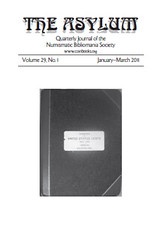 I've sent another issue of The Asylum to the printers. Here are the
contents:
I've sent another issue of The Asylum to the printers. Here are the
contents:
- Dan Hamelberg - President's Message
- Benny Bolin - Fractional Currency Literature
- Myron Xenos - "You Don't Say": Numismatic Quarterly Quiz
- Denis W. Loring - Charles L. Clarke—Unpublished Numismatic Author
- Dave Hirt - Circulation Finds
- David D. Gladfelter - Book Review: Tales from the Bourse
- List of Issues of The Asylum by Volume and Number, 1980-2010
For an NBS membership application, see: coinbooks.org/about/membership.html
SOME LOT ILLUSTRATIONS CZAHOR MAIL BID SALE XV CLOSES
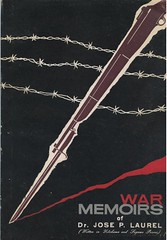
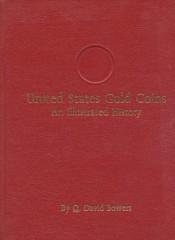
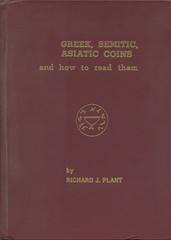
To read the earlier E-Sylum article, see: CZAHOR MAIL BID SALE XV CLOSES JUNE 14, 2011 (www.coinbooks.org/esylum_v14n19a02.html)
NEW BOOK: STRIKE IT RICH WITH POCKET CHANGE, 3RD EDITION
 Strike It Rich With Pocket Change, 3rd Edition
Strike It Rich With Pocket Change, 3rd Edition
Error Coins Bring Big Money
By Ken Potter and Dr. Brian Allen
Can You Spot the Errors in Everyday Coins?
Imagine fishing in your pocket for change to buy a candy bar and discovering a nickel worth $50—not a bad day! The truth is the U.S. Mint, through production mishaps, has and will continue to create a small but significant number of "mistakes." Discoveries range from a couple bucks to several thousand! No computers or coin dealers are necessary with this book, just a fist full of coins.
Unlike rare and obsolete coins, these hidden treasures are laying around in cash drawers and piggy banks, waiting for the common eye to spot them. This book is a clear and simple guide to prepare any collector or treasure hunter to spot rare coins the average consumer normally would never notice.
With the potential to uncover valuable rarities, this book will bring out the treasure hunter in anyone! It's perfect for both novice and expert collectors, as well as providing an indispensable tool for U.S. coin dealers and researchers.
Strike It Rich provides hundreds of impressive, detailed images for accurate identification and a comprehensive grading guide in plain English. There is no need for previous knowledge to get started! Each page has a detailed description with diagramed photos to help identify each coin and to clarify the type and degree of error.
Get started on your treasure hunt now! Empty your purses and turn out your pockets—maybe your penny will be worth more than a thousand words.
About the Authors
Ken Potter and Dr. Brian Allen are leading experts in the field with an absolute passion for uncovering the next scarce variety that eludes the U.S. Mint's quality control procedures. Ken Potter has been a dealer in U.S. coins, specializing in errors and varieties, for many years with a sterling reputation for accuracy and a keen eye. You can visit his website which he regularly updates with new coin discoveries: http://koinpro.tripod.com. Brian Allen has been collecting since childhood. He is a founding member of the National Collector's Association of Die Doubling and has co-authored three coin-related books.
US $19.99 (CAN $22.99) | 978-1-4402-1578-0 | (Y1748) 352 pages
Krause Publications, a division F+W Media, Inc.
BOOK REVIEW: THE ENCYCLOPEDIA OF THE LIBYAN BANKNOTES
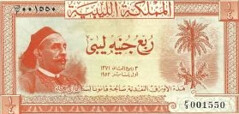 The Encyclopedia of the Libyan Banknotes is its title, and it was written by Dr. Ali Mehilba, well-known numismatic scholar in Middle Eastern numismatics. With Libya so much in the news these days, the emergence of this particular book may have an added degree of interest as any possible change of regime would of course necessitate a new series of bank notes.
The Encyclopedia of the Libyan Banknotes is its title, and it was written by Dr. Ali Mehilba, well-known numismatic scholar in Middle Eastern numismatics. With Libya so much in the news these days, the emergence of this particular book may have an added degree of interest as any possible change of regime would of course necessitate a new series of bank notes.
The book will be popular because the text appears in both Arabic and English. Proceeding by chapters, the first one deals with an historical perspective on the country and some of its leading personalities through the years. Chapter II takes a close look at grading standards using the International Bank Note Society as a guide, and giving comparative abbreviations for various grades as used in a number of countries. There is also some discussion about the effects of grading on the value of a note, particularly if the piece is desired for investment. The various signatures found on Libyan bank notes are listed with the years they appeared, along with some pictures of the individual signers themselves.
Chapter III, the heart of the book, begins the listing of bank notes, proceeding by issuer. After a thorough analysis of the issue as a whole, each note is presented; data given consists of its own list of specifics, a face and back illustration in color, and a catalog listing including values in five grades. Catalog numbers are based on those in the Pick references; values appear to be in U.S. dollars though this fact is not stated. Issues progress in the following order: Kingdom of Libya, United Kingdom of Libya, National Bank of Libya, Bank of Libya, and Central Bank of Libya.
When one observes the dates on the first two issues, it would seem that they are correctly listed in the Standard Catalog. Notes of the United Kingdom were made under Law No. 4 of 24th October 1951 as stated on the pieces themselves. But according to this new reference, the King Idris portrait notes with their date of Jan. 1, 1952 and issued under the Kingdom of Libya actually come before those with the 1951 Law date. Apparently there was agitation for the removal of the king's effigy, so the next issue, United Kingdom notes with illustrations of some famous ruins in Libya, replaced those showing the king; they may have been issued under the 1951 Law date but certainly after the portrait notes of 1952.
After going through all government issues from beginning to end, this same chapter continues with two well-known World War II military-related emissions: British issue for Tripolitania in lire, and French occupation of the Fezzan.
Chapter IV deals with counterfeiting of regular-issue Libyan bank notes, followed by a detailed discussion of genuine pieces and forgeries of Fezzan overprints by world expert Joe Boling. A number of illustrations highlighting his presentation are provided to help clarify the problems involved.
To sum it up, collectors will find this reference a valuable tool in their pursuit of this series full of history amid notes of real rarity. While there are a few rougher spots in the English text, there is no problem with understanding it fully. The author is to be highly commended for a fine piece of pioneering work with the notes of Libya.
To read the complete article, see: New Book on Libyan Bank Note (www.numismaster.com/ta/numis/Article.jsp?ad=article&ArticleId=19974)
THE BOOK BAZARRE
8TH ANNUAL SOCIETY OF PAPER MONEY COLLECTORS AUTHORS FORUM JUNE 10, 2011
The 8th Annual Society of Paper Money Collectors Authors Forum will be held on June 10, noon-2p.m. in the Marriott Heritage Ballroom during the upcoming Memphis International Paper Money Show. The event is part of SPMC's golden 50th anniversary celebration. "The Welcome Mat is out," said SPMC President Mark Anderson, who will greet attendees at the event. The event is free to the public.
Speakers for the forum are diverse and promise something of interest to all collectors, noted forum organizer Fred Reed. "Once again we've got a stellar lineup of authors eager to tell about their new books and share their insights into the book publishing process with prospective authors and other readers," Reed added.
Leading off the forum will be Confederate Currency authority Pierre Fricke. Fricke, author of several successful CSA titles in recent years, will present an illustrated survey of his new title "The History of Collecting Confederate Paper Money," coauthored with Bank Note Reporter columnist Fred Reed. In fact, the root of the book is the series of articles Reed contributed to BNR in his "Shades of the Blue & Grey" column during 2004-2007.
Noted Southeast Asia specialist and author Howard Daniel will speak on his new "Socialist Republic of Viet Nam Coins & Currency." Daniel is author of a series of books on Vietnamese numismatics. The Army veteran splits his time between homes in Virginia and Viet Nam. It took censors in Hanoi months to clear the new book for publication and sale in Viet Nam, Daniel reported.
In keeping with the theme of the convention, Past Token & Medal Society President Bob Leonard will discuss the paper aspects of his wonderful new book on curious forms of exchange, "Curious Currency: The Story of Money from the Stone Age to the Internet Age." An expert on primitive money, curious currency in the author's view includes "paper" money materials, counterfeits, bills of exchange, checks, notes payable in labor, encased stamps and other items.
F&W Publications paper money guru Bill Brandimore will discuss new projects simmering on the stove in far off Iola, WI including the latest edition of the "Standard Catalog of United States Paper Money." Brandimore and George Cuhaj are responsible for the lively and colorful catalog. Brandimore also writes a column and provides price guide commentary on the U.S. series for Bank Note Reporter.
Noted World War II and military currency specialist Fred Schwan will be on hand to discuss his colorful new work "World War II United States Savings Bonds and Stamps." This new reference is co-authored by Larry Smulczenski, James Downey and Mark Watson. The work debuted at this Spring's MPCFest.
Bringing up the rear in the lineup will be BNR columnist Fred Reed, who will discuss the upcoming sequel to his 2009 book on Lincoln numismatics for Old Abe's Bicentennial. The new work, "Abraham Lincoln: Beyond the American Icon," gives Reed a chance to develop the themes he introduced in his original Lincoln book. Reed's research has shown that Lincoln's money images are normative in advertising, media, and popular culture. "The Lincoln on the money, is the Lincoln people know best," Reed said.
As in recent past years, the Forum will be kept lively by emcee author and raconteur Wendell Wolka. "The Forum is free. Come on up to the ballroom at noon on Friday and share an enjoyable break from your hectic show schedule," Wolka suggested.
For a half century SPMC has been an international group of hobbyists that fosters collecting and study of bank notes and other paper collectibles. Dues are only $30 annually for U.S. addresses. Others inquire. Members receive the Society's award-winning, bimonthly journal "Paper Money." For information on SPMC, contact Membership Director Frank Clark, P.O. Box 117060, Carrollton, TX 75011-7060.
HISTORICAL MARKERS AND NUMISMATIC HISTORY
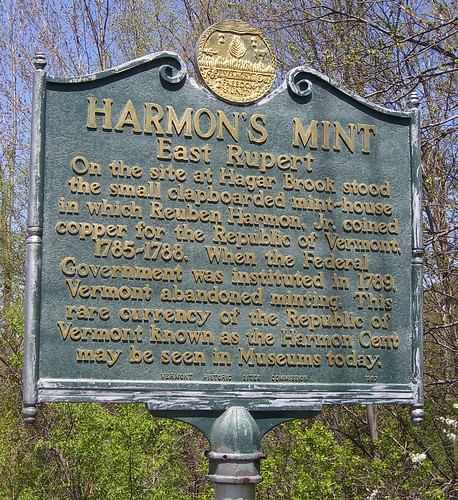
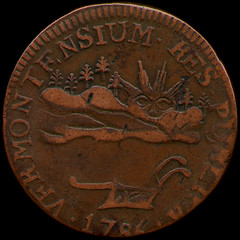 The day after the Stack's auction in June, 1994, three colonial nuts went out in search of numismatic history. Our goals were to examine the Connecticut coppers in the collection of the Connecticut State Library for a day and then drive over the Green Mountains to view the Vermont coppers in the collection of the Bennington Museum. If we had the time – and you just knew we'd make time! -- we were going to try to track down the probable site of Reuben Harmon's mint, the one responsible for many of the Vermont coppers.
The day after the Stack's auction in June, 1994, three colonial nuts went out in search of numismatic history. Our goals were to examine the Connecticut coppers in the collection of the Connecticut State Library for a day and then drive over the Green Mountains to view the Vermont coppers in the collection of the Bennington Museum. If we had the time – and you just knew we'd make time! -- we were going to try to track down the probable site of Reuben Harmon's mint, the one responsible for many of the Vermont coppers.
Gene Kosche, the gracious retired curator of history at the Bennington Museum, arranged for us to view the collection and take notes and then casually dropped a bombshell on use. "Have you folks been over to see the mint building?" Three dumbfounded stares answered his question and a few minutes later one of us recovered our senses enough to blurt out that all accounts of the building indicated that it had been destroyed in a storm nearly 150 years ago. "Nah, it's over on Bob Graf's farm – everyone ‘round here knows about it. You really ought to see it."
Talk about waving a red flag in front of some copper bulls! Early the next day, with plenty of sunlight to help, we headed north out of Bennington. About half an hour later we passed through the town of Dorset on Highway 30. This is the "main road leading from Dorset to Pawlet" mentioned in Crosby, and appears to follow roughly the same path as it did two centuries ago. Just north of Dorset we crossed over the Pawlet River. We were on Reuben Harmon's home turf, and we were getting close. About half a mile further we crossed a small creek and struck paydirt. This is the "small stream of water called Millbrook" that Harmon used to power his rolling mill.
Continuing towards Pawlet we passed the Graf place, called Southwind Farm, made a quick U-turn and pulled into the driveway. Bob Graf was out of town, but his son-in-law was mowing the lawn and came over to talk to us. We asked about the mint building and with a hearty laugh he said "You want to see old Harmon's mint? It's right over here." He led us to a small garage just off the main driveway and said "You guys look around all you want. I've got to finish the yard, so just turn out the light when you're done."
The building itself looked promising. While the roof and siding were old they certainly weren't more than three or four decades in age, and the cement floor was probably not what Reuben Harmon would have put in. The frame of the building, however, was of a much earlier vintage – rough hewn and assembled by mortise and tenon – and almost certainly late 18th Century. We paced out the size of the building, figuring it at roughly 16 by 20 feet, a pretty close match to Crosby's description of "about 16 by 18 feet." The age, size, and structure of the building fit what we knew about the mint, and local lore has ascribed it as the mint building for at least the last century, usually with that special New England flair that mixes pride for their history and extreme surprise that anyone else should care.
We spent about two hours searching the area with a metal detector, hoping to locate at least a few landscape Vermonts (or an original die or two!), but only came up with a few broken bits of pottery and a rusted metal ring about two inches in diameter, probably from some type of horse's tack.
As the sun was beginning to set we headed south back towards Bennington. Looking up at the mountains we all realized that the landscape Vermonts are not the stylized depiction that collectors assume them to be, but are rather a pretty accurate picture of the view from Reuben Harmon's own land. Gazing up at their majestic beauty, it was easy to understand why the Green Mountain Boys emerged over two centuries ago and fought for their property.
In the end, we all agreed that everything looked right: if we were going to plan a mint, the building on Bob Graf's farm would have been perfect for the job, and we would have chosen the place at the mouth of the canyon where Millbrook descended from the mountains. We also began to wonder if Sylvester Crosby ever spent a sunny weekend afternoon wading up a river!
The reference is: Retz, Rob; Rock, Jeff; and Thies, Dick. In Search Of… Reuben Harmon's Vermont Mint and the Original Mint Site. The Colonial Newsletter. September, 1996. Volume 36 Number 3. pp. 1655-1658. Reprinted by permission of the authors, bless ‘em, and the Colonial Newsletter Foundation. For more information, see today's Featured Web Page.
To read the complete article, see: VERMONT VACATIONING (www.alfirin.net/wcc/wcc97jan.html)
QUERY: CELL PHONE CAMERAS FOR TAKING NUMISMATIC IMAGES
Bruce W. Smith writes:
I am thinking of buying a cell phone and understand that most now come with the ability to take images. What I want to know is, has anyone compared different phones for the ability to take images of coins or paper money? Maybe none of them will image something that small. Does anyone know? If I buy a new cell phone, I would want one which can take images of coins and notes.
THE BOOK BAZARRE
NOTES FROM E-SYLUM READERS: MAY 15, 2011
Regarding Philip Mernick's question about ordering the book, Coins of Indian States - Part A" by L. C. Bawa & S. C. Gupta, P.K. Saha writes:
I will be going to India in October and can ensure shipment of the book.
To read the earlier E-Sylum article, see: NOTES FROM E-SYLUM READERS: MAY 8, 2011 (www.coinbooks.org/esylum_v14n19a10.html)
Regarding the bronze Albert Medal discussed last week, I asked via Facebook if anyone could locate an image of a GOLD one. Dan Friedus writes:
Lot 42 in this sale (Spink "Orders, Decorations, Campaign Medals and Militaria," Thursday 19 November 2009) is a gold Albert medal and it is illustrated: www.spink.com/auctions/pdf/9033.pdf
Albert Medal of the First Class (MED0564) (www.nmm.ac.uk/collections/explore/object.cfm?ID=MED0564)
DICK JOHNSON'S SPOTLIGHT ON SILVER
Recently I had noticed an increasing number of silver items being offered in auction sales around the country. As the price of silver rises, citizens often examine their holdings of silver items in their households. Are those candlesticks received as a wedding gift so many years ago still an item to keep? Or should they be converted to cash as their value as bullion rises above their value as a utilitarian item in the home. For many the answer has been to sell.
These days we are bombarded with advertisements in newspapers and on TV -- sell us your old gold and silver. Also the ads encouraging us to buy bullion gold and silver are just as compelling. I observed this week silver spiked into the $40s for an ounce of silver, then dropped back into the $30s. Midweek I plunged and bought a sizable amount on the drop in price.
We also observe the soothsayers telling us of an impending meltdown in the American economy, the dollar may drop as the world's universal currency, and that a financial panic is possible. Survivalists tell us to have on hand six months supply of food, water and medicines. Then put as much as you can afford into gold and silver bullion.
But what would happen if we did have to use those bullion items for, say, purchases at the supermarket? What kind of coins or cash do we offer vendors? I don't see banks being bullion dealers, accepting silver rounds in exchange for some kind of coin or cash the supermarket would accept. I do foresee, however, coin dealers becoming money changers -- even bullion dealers! -- accepting bullion coins for spendable cash.
For all those citizens with a stash of gold and silver bullion, they should become friends with their local coin dealer. After all, he may be your best bet, when your bank refuses to accept those bullion coins.
This is not a statement in any way to encourage you to acquire bullion in any form, but I would like to expose you to the following article: www.moneynews.com/Advani/ashish-advani-silver-gold/2011/05/11/id/395921
Then go visit your local coin dealer. Make sure he remembers you. You might need his services in the near future.
AMERICA'S FIRST BANK BURGLARY?
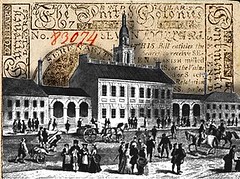 The yellow fever outbreak of summer 1798 was the worst in Philadelphia's history. Over 5,000 residents were infected, and nearly 1,300 died, causing even President Washington to flee. While yellow fever swept the city, hot heads prevailed when a huge sum of money went missing from the vaults of a bank. This was America's first bank robbery.
The yellow fever outbreak of summer 1798 was the worst in Philadelphia's history. Over 5,000 residents were infected, and nearly 1,300 died, causing even President Washington to flee. While yellow fever swept the city, hot heads prevailed when a huge sum of money went missing from the vaults of a bank. This was America's first bank robbery.
Carpenter's Hall was built in 1770 and had been a meeting place for the First Continental Congress, home of the Philadelphia Library, and until the year preceding the robbery had housed the Bank of the United States. The new tenant of the building was to be the Bank of Pennsylvania, who had hired Samuel Robinson to oversee the move. One of the first things that needed to be done before moving into the building was the changing of the locks on the vaults. During the summer of 1798, Robinson hired a local blacksmith, Pat Lyon, to do the job. Lyon was on the verge of leaving the city because of the yellow fever outbreak, but took on the rush job before he left town. While Lyon was working on the vault, Robinson brought a stranger to watch him work.
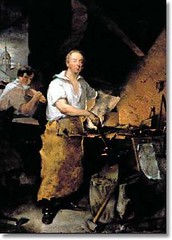 After completing the job, Lyon and his apprentice left town, taking a ship to Delaware. Two days after their arrival, the apprentice died of yellow fever. Reading the newspaper while he was away, Lyon was interested in accounts of a robbery at Carpenter's Hall on the night of September 1, where he had changed the locks on the vaults just before leaving. The massive amount of $162,821 ($2.9 million today) had been stolen, and blacksmith Pat Lyon was a prime suspect.
After completing the job, Lyon and his apprentice left town, taking a ship to Delaware. Two days after their arrival, the apprentice died of yellow fever. Reading the newspaper while he was away, Lyon was interested in accounts of a robbery at Carpenter's Hall on the night of September 1, where he had changed the locks on the vaults just before leaving. The massive amount of $162,821 ($2.9 million today) had been stolen, and blacksmith Pat Lyon was a prime suspect.
There were no signs of forced entry, so it must have been an inside job. The authorities suspected that Lyon had simply made himself an extra key and entered the vaults the night before he left town. Lyon felt the need to return to Philadelphia and tell his side of the story. Lyon explained that he suspected Samuel Robinson and the stranger as the real thieves. The authorities were not convinced. Pat Lyon was arrested and thrown in Walnut Street Prison.
After leaving prison, Lyon wrote a book with the incredible title of "The Narrative of Patrick Lyon: who Suffered Three Months Severe Imprisonment on Merely a Vague Suspicion of Being Concerned in the Robbery of the Bank of Pennsylvania, with his Remarks Thereon".
Lyon's portrait was painted by John Neagle, whose painting is titled Pat Lyon at the Forge. It is an excellent likeness of Lyon, and the spire of Walnut Street Prison where Lyon was held is shown in the background.
A modern numismatist would be willing to rob the bank himself to get some of the specimens that would have been inside. There were probably several chain cents, possibly an early half dollar, and certainly a large stash of Spanish dollars (the legendary piece of eight), which were legal tender in the U.S. until 1857.
To read the complete article, see:
America's First Bank Robbery
(www.coinweek.com/coin-guide/numismatic-history/
rica%E2%80%99s-first-bank-robbery/)
KOLBE & FANNING JUNE 2, 2011 SALE HIGHLIGHTS
Rare and Unusual Publications on American Numismatics IncludingA rare 1944 Stack's flyer promoting the Col. Flanagan sale,
featuring the notorious "$20.00…the famous 1933 which
will be the first specimen ever offered at auction sale";
A receipt for Hiram Deats's 1904 subscription to
The Numismatist, signed by Dr. Heath;
An original 1863 San Francisco Mint document recording the
employment of Bret Harte
Catalogue Available at Our Web Site: www.numislit.com
Printed Catalogues $10.00
KOLBE & FANNING NUMISMATIC BOOKSELLERS
141 W JOHNSTOWN ROAD, GAHANNA OH 43230-2700
(614) 414-0855 • df@numislit.com • GFK@numislit.com
RESPONSES ON CATALOGS FOR FLYING EAGLE CENT PATTERN RESEARCH
Dam Hamelberg writes:
I have the catalogs that R. V. Dewey listed in his quest for information on the 1855 set of Flying Eagle cents. There are no U.S. coins in the Bangs sales (2) listed for 6 - 17 - 1870. Both sales held by Bangs contained Greek and Roman coins. The Mason sale held on 6 - 17 - 1870 contained lot 364: "1855; complete set of Flying Eagle Cents; copper, brass, nickel, composition, etc.; proofs; as sets very rare; 8 pieces." It sold for 75 cents. The Steigerwalt sale on 5 - 21 - 1907 contained lot 1483: "1855. Cents. Flying Eagle. Six specimens, said to illustrate the various alloys, from copper to nearly pure nickel, in which they were struck. These are supposed to be from the Mint where used as samples. Five have very light marks, as III, IV, said to be the checks made at Mint. Two show trifling weakness in striking; others are dull proofs. 6 pcs." No prices on this lot.
David Stone writes:
I can supply the auction description from the Appleton/Stamm Collections (Charles Steigerwalt, 5/1907), lot 1483:
"1855. Cents. Flying eagle. Six specimens, said to illustrate the various alloys, from copper to nearly pure nickel, in which they were struck. These are supposed to be from the Mint where used as samples. Five have very light marks, as III, IV, said to be the checks made at Mint. Two show trifling weakness in striking; others are dull proofs. 6 pcs."
John Eshbach writes:
I have a copy of Steigerwalt's sale #62. It was the Appleton sale part 1. It is priced and the lot R. V. Dewey asked about was number 1483, which sold for $6.00.
To read the earlier E-Sylum article, see: QUERY: CATALOGS SOUGHT FOR FLYING EAGLE CENT PATTERN RESEARCH (www.coinbooks.org/esylum_v14n19a09.html)
MORE ON CLIFFORD HEWITT
Jan Monroe asks:
Was Clifford Hewitt related to Lee Hewitt, editor of the Numismatic Scrapbook?
David Hill, Archivist of the American Numismatic Society writes:
We have a small collection relating to Hewitt in the ANS Archives. http://numismatics.org/Archives/Chewittbio# . Among other things, it contains correspondence and biographical information, some of which has been incorporated into the collection description. I would be happy to provide Mr. Smith with more information, if he'd like to get in touch. Regarding Hewitt's activities after the Shanghai Mint, this is from a biographical sketch in the collection: "He held the position and title of technical mint expert throughout his 12 years of service in China until March 1933 when he retired to his home in San Diego." As for Hewitt's full name, I haven't encountered the use of an initial or anything fuller than "Clifford Hewitt" in his official correspondence or elsewhere.
 Clifford Hewitt (1869-1942) of Philadelphia, was born in Hazelton, Pennsylvania. He was chief mechanical engineer for the U.S. Mint and was instrumental in projects involving the building and equipping of the mints of Philadelphia, Denver, Manila, and Shanghai. He also built and installed a mint exhibit at the St. Louis Exposition of 1904 and designed coins, such as the Wilson Dollar commemorating the opening of the Manila Mint in 1920 and a Sun Yet Sen coin for the opening of the Chinese Mint in 1933.
Clifford Hewitt (1869-1942) of Philadelphia, was born in Hazelton, Pennsylvania. He was chief mechanical engineer for the U.S. Mint and was instrumental in projects involving the building and equipping of the mints of Philadelphia, Denver, Manila, and Shanghai. He also built and installed a mint exhibit at the St. Louis Exposition of 1904 and designed coins, such as the Wilson Dollar commemorating the opening of the Manila Mint in 1920 and a Sun Yet Sen coin for the opening of the Chinese Mint in 1933.
Hewitt was the son of Isaac Hewitt and grandson of Thomas Hewitt, both early railroad engineers. Clifford began his training with the Janesville Ironworks in Pennsylvania and went on to graduate from the Franklin Institute of Mechanical Engineering in Philadelphia in 1893. He oversaw the design and building of the Manila Mint, the only U.S. mint established outside of the continental United States, and was then contracted by the Chinese government to serve as technical mint expert for the Shanghai mint project, a position he held from 1920 to 1933, the year the mint opened. He later retired to San Diego.
To read the complete archive entry, see: Clifford Hewitt Chinese Mint collection, 1930-1934 (numismatics.org/Archives/Chewittbio)
NBS Board Member Marc C. Ricard writes:
I was able to find a few more details. After reading that Mr. Hewitt retired to San Deigo, a quick check of the California Death Record archive for 1942 reveals that there was no middle name or initial in the record, and that it appears that Clifford was indeed his first name. He died on October 11, 1942.
I was unable to find an obituary in the archives of any San Diego newspapers around that date, that was available free of charge. If someone in our community has a membership to Ancestry.com, those records may be available there.
Bruce Smith adds:
I should have mentioned that I already knew about the Hewitt Collection at the ANS. In fact, it seems I know more about it than they do. Here is an outline.
At some point after he left the Shanghai Mint in 1933, Clifford Hewitt retired to San Diego, California. His collection was acquired by San Diego coin dealer, Edward P. Janzen, probably in the late 1960's. According to R. B. White, Janzen was a US Army officer serving in China at the end World War II, and was one of the first Americans to enter Peking at the end of the war. Sometime after the war, Janzen settled in San Diego. Janzen put together an exhibit of the Hewitt collection for the 1971 ANA convention in Washington DC. The collection was photographed by professional numismatic photographer, Larry Stevens, and a story about the collection, with some of Stevens' photos, was published in CoinAge magazine December 1971.
Janzen sold some items out of the collection, probably before it was exhibited. R. B. White bought examples of the copper coins in the collection. Janzen consigned the exhibited collection to the Superior sale at the 1975 ANA, where it was listed as one lot with a three page description. The lot sold for $7,500 -- apparently to dealer Frederick S. Werner, who donated it to the ANS in 1977.
Another article about the collection, by Chang Kan-sheng, was published in Chinese in Numismatic World Bimonthly #3 (May 1977). This article contained additional images, including a letter dated 10 November 1931 from Philadelphia Mint engraver, John Sinnock, to Hewitt, discussing problems they had producing dies for the Shanghai Mint. Trial strikings were made of several different coins.
The Werner donation was noted in the 1977 ANS annual report, with a photo of a Shanghai Mint Completion medal and half of a Yuan Shih Kai dollar which was handstamped "Hangchow 1921 No.4." The other half of this coin was apparently used for assay purposes. Hangchow was one of the mints which struck the Yuan Shih Kai dollar before the Shanghai Mint opened. The ANS report says 27 items were in the collection given to the ANS, but this must be the number of coins and medals, in addition to the documents, letters, photographs and sketches.
To read the earlier E-Sylum article, see: QUERY: INFORMATION ON CLIFFORD HEWITT (1869-1942) SOUGHT (www.coinbooks.org/esylum_v14n19a08.html)
COINS AT THE BAD SäCKINGEN GERMANY DARK AGE FESTIVAL
From April 29 to May 1, 2011 a Dark Age Festival took place at Bad Säckingen in Southern Germany. The organizers, the worldwide dominant traveling organization of festivals of this kind call themselves MPS, which stands for Middle Ages – Fantasy (German: Phantasie) – Spectacle. The response was incredible, which gives us a good reason to reflect, why the Middle Ages are so popular and why museums can't benefit a little bit more from this trend.


Of course there is a numismatic aspect of the Dark Ages Festival. They have created an own festival currency: the golden crown featuring "medieval" pictures like dog heads and logos. The festival currency can be swapped for euros at the moneychanger's table.
There are 5-euro, 2-euro, 1-euro and 1/2-euro crowns; and every year two new emissions are issued. This is important, as MPS wants to seduce their visitors to collect. Since 2009 these crowns have been on the market and they will stay until 2016. All visitors, who are able to show all issues at the end of this period will take part in a lottery. Their participation will cost a lot of money: one golden crown corresponds to one euro. If you collect all denominations of all issues for 8 years, this will be a substantial amount. And we shouldn't forget, that there will be a lot of collectors starting their collection, who will have forgotten it in 2016.
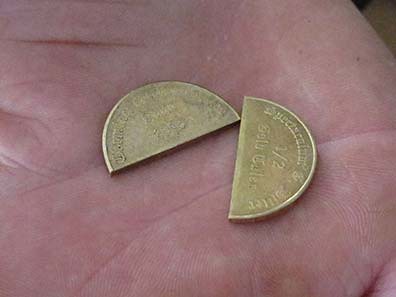
To read the complete article, see: Spectaculum: About Golden Crowns and odd disguises (www.coinsweekly.com/en/News/4?&id=583)
HOW MANY OF THE 100 GREATEST MODERN COINS
DO YOU OWN?
THE ROYAL AIR FORCE DISTINGUISHED FLYING MEDAL
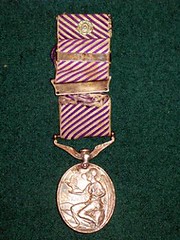 RARE medals of an RAF hero who flew a staggering 350 missions in the Second World War are expected to fetch thousands of pounds in auction.
RARE medals of an RAF hero who flew a staggering 350 missions in the Second World War are expected to fetch thousands of pounds in auction.
The collection of memorabilia consists of at least five medals, a flying logbook and press cuttings detailing the local man's extensive war services.
But the item which has caused the most excitement is an extremely rare Distinguished Flying Medal with the significant addition of a silver bar on the ribbon.
Bill Tag, a war medal expert, said: "The little silver bar with a crown on it shows that he won the DFM not once but twice – a fact that even his family was not aware of, and a rare achievement given that the average life expectancy of bomber crews was eight weeks."
The St Helens gunner took part in 350 missions in total over Germany and Italy, from 1940 to 1945.
Bill, the owner of Liverpool Militaria in the city centre, said: "Quite a few DFMs were issued to the brave men that fought in the Second World War, but there would have been very few bars ordered.
"I've only seen one or two sold in the north west over the past 20 years because they are so personal and valuable to the families."
To read the complete article, see:
RAF hero's rare medals to go under the hammer
(www.sthelensstar.co.uk/news/9022026.RAF_hero_s_rare_
medals_to_go_under_the_hammer/)
DISTANT RELATIVES LOCK IN BIDDING WAR OVER ANCESTOR'S MEDAL
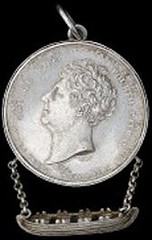 A "very rare" silver medal awarded to a Cornish hero who masterminded the rescue of sixteen seamen in two separate incidents off the Plymouth coast 160 years ago sold for £7,500 – more than treble the expected sum – at an auction.
A "very rare" silver medal awarded to a Cornish hero who masterminded the rescue of sixteen seamen in two separate incidents off the Plymouth coast 160 years ago sold for £7,500 – more than treble the expected sum – at an auction.
Before the auction at Spink in London, the Royal National Institution For The Preservation Of Life From Shipwreck medal – presented to fearless Trinity House pilot Richard Eddey – had been expected to fetch between £1,500 and £2,000. But determined bidders were so keen to buy the medal that those cautious pre-sale estimates were swiftly overtaken.
To read the complete article, see:
Mystery bidder buys rare medal for £7,500
(www.thisiscornwall.co.uk/news/Mystery-bidder-buys-rare
-medal-163-7-500/article-3483973-detail/article.html)
A rare rescue medal awarded to a Cornishman more than 150 years ago sold for three times its auction estimate, after two members of his extended family unwittingly found themselves bidding against each other.
Trinity House pilot Richard Eddey, of Cawsand, was twice awarded the Royal National Institution for the Preservation of Life from Shipwreck medal after he helped save the lives of 16 men in two separate rescues in 1824 and 1843.
His medal – with attached silver boat marking the second award – is one of only six examples in the country. So it attracted considerable interest when it went to auction, with a guide prices of £1,500 to £2,000, at Spink London two weeks ago.
After a bidding war it was eventually bought for £7,500 by Frank Williams – Eddey's great-great-great grandson – who had been determined to bring the heirloom back into the family.
What he didn't know was that he had been bidding against Julian Hocken – Eddey's great-great-great-great nephew – who wanted the medal for the same reason.
"I had learned about the medal's existence in 2000 from Peter Helmore, general secretary of the Orders and Medal Research Society who had just read my history of the Eddey family," 80-year-old Mr Williams, a retired managing director from Oxford, told the Western Morning News.
"He told me that the medal had been sold at auction for £1,400 at Spinks in 1995. I asked him to let me know if it ever re-emerged on the market and six weeks ago he alerted me to its forthcoming auction.
"I was determined to bring the medal back into the family after more than 160 years, but at the auction I was alarmed at the way bidding escalated, with just one person against me.
"I pressed on to my limit, and after the auction, with my finances severely depleted, I met my opponent.
"It transpired that he was Richard's great-great-great-great nephew, and equally determined to secure a family heirloom. We parted friends despite the expensive coincidence."
Mr Hocken said he already knew of his ancestor's exploits and was told by a friend that the rare medal was coming up for auction.
"I was obviously disappointed but when I heard Frank's story I was really pleased for him," said 40-year-old Mr Hocken, from the Isle of Wight, said. "Frank has done a lot of work on the Eddey family history and it obviously means a lot to him. I'm just very sorry that I cost him a bit of extra money."
To read the complete article, see:
Surprise for bidders after hero's medal is auctioned
(www.thisisdevon.co.uk/news/Surprise-bidders-hero-s-medal
-auctioned/article-3531336-detail/article.html)
THE "RUB AND SNIFF" MARIJUANA COIN
David Klinger writes:
NOW I HAVE SEEN EVERYTHING ! I hope this does not signal the future direction of numismatics. I would much rather tolerate the smell of tobacco on my currency and books.
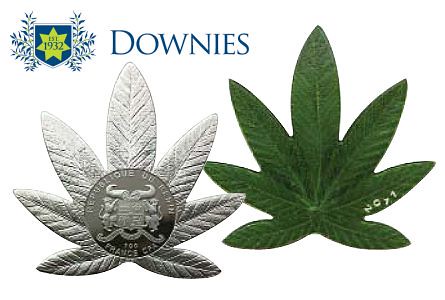
Set for release May 20 2011, the "Rub and Sniff" design is one of the few scented coins in numismatics.
Distinctively leaf shaped, this iconic 2011 coin releases the aroma of cannabis when the reverse is rubbed. An official Benin legal tender issue, the obverse is distinguished by the national Coat of Arms.
The Republic of Benin is a country in West Africa. It borders Togo to the west, Nigeria to the east and Burkina Faso and Niger to the north. Its small southern coastline on the Bight of Benin is where a majority of the population is located.
The capital of Benin is Porto-Novo, but the seat of government is located in the country's largest city of Cotonou. Benin covers an area of approximately 110,000 square kilometers (42,000 sq mi), with a population of approximately 9.05 million.
The Benin 2011 Marijuana Scented Silver Plated coin will be available for $79.50.
Throughout the colonial period the territory of Vermont was claimed by both New Hampshire and New York. On January 15, 1777, six months after the original thirteen colonies declared their independence from England, Vermont proclaimed itself to be an independent republic and remained so until admitted to the union as the fourteenth state on March 4, 1791. The Republic of Vermont became the first American local government to authorize and establish a mint to produce coins. On June 10, 1785 the House of Representatives of the Freemen of Vermont appointed a three member committee to study a petition from Reuben Harmon, Jr. requesting that he be allowed to mint copper coins, a fourth committee member was added from the upper chamber known as the Governor's Council.
Five days later, on June 15th the committee presented an act to the legislature that would grant Harmon an exclusive two year right to mint coppers within the Republic starting July 1, 1785. It was stipulated the coppers had to weigh one third of an ounce troy weight (160 grains) and that they would contain designs and mottos approved by the committee. Harmon was also required to post a bond of £5,000. On that same day, the act was read and approved by the House and sent up and to the Council where the members voted to concur with the House, approving the measure into law. Interestingly, although Vermont was an independent republic, the legislature continually referred to itself as a state in their legislation, hence the act says Harmon was granted "...the exclusive right of coining Copper within this State for the term of two years...".
The day after Harmon's coining petition was granted, June 16, 1785, he posted the required bond and presumably began setting up his mint in Rupert, Vermont. The first location of the mint was on the north side of Millbrook Stream. In the mid 1850's Charles Bushnell sent letters inquiring about information on several confederation era mints. At that time some elderly local residents remembered these mints in operation during their youth.
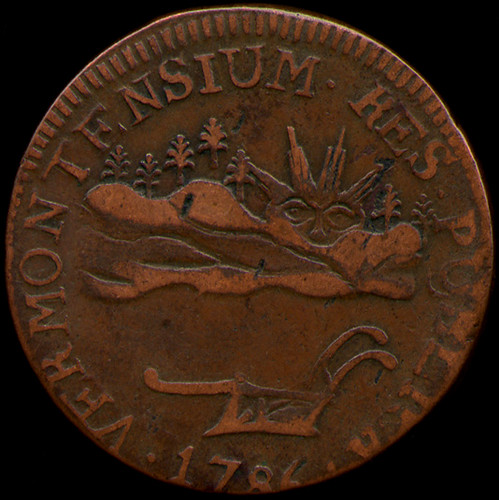
www.coins.nd.edu/ColCoin/ColCoinIntros/VT-Copper.intro.html

